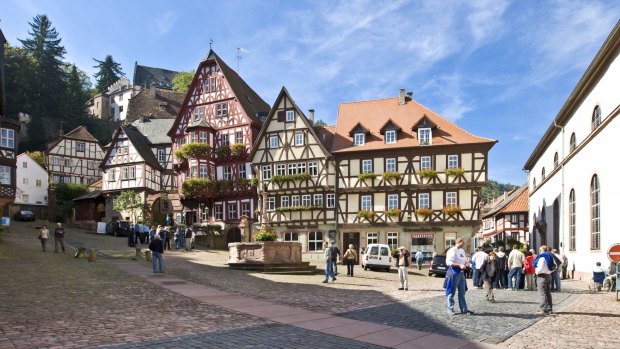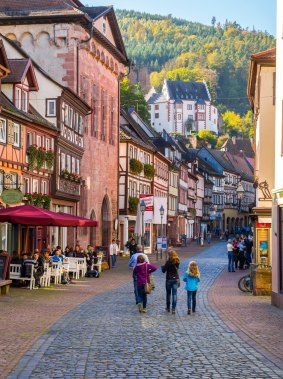This was published 6 years ago
Miltenberg, Germany: a cruise tour to one of Germany's oldest and best-preserved towns
By Alison Stewart

Find traces of history dating back to the Bronze Age in Miltenberg, Germany.Credit: Alamy
In a world that relentlessly tears down its history for bigger, shinier, newer iterations, it's a joy to visit Germany's Miltenberg and marvel at the history embodied in the pristine half-timbered houses and crooked cobblestoned streets.
Further layers of history are evidenced in the preserved Bronze Age tumuli, Celtic hill forts and Roman ruins and castle.
Historic Miltenberg, tucked into a "knee" of the Main River between the Spessart and Odenwald ranges in Lower Franconia, is like a mythical galleon that sails on through a changing world, resilient and enduring.

Photogenic Miltenberg.Credit: Alamy
The enchanting town of about 9500 people is preserved in time thanks to one of the world's most destructive conflicts. The Thirty Years' War in the 1600s, which left eight million dead, demolished prosperity. Miltenbergers simply could not afford an upgrade.
Our visit to one of Germany's best-conserved towns is included in our 15-day APT Magnificent Europe river cruise on the AmaBella. An entertaining Glaswegian in lederhosen, who met a local lass and never left, escorts us on an idiosyncratic walking tour. His quirky take on Miltenberg matches the quirky buildings.
We learn about the Middle Age monks' predilection for magic mushroom-flavoured beer, the day Elvis came to the oldest inn in Germany, the amount of wine people drank in medieval times (about eight litres daily), the reason witches were burned in the town square (birthmarks, red hair, a fondness for cats), the medicinal applications of the town's apothecaries' herb garden (wormwood as an aphrodisiac) and why the top half of a medieval house is larger than the foundations (area-based taxes).
Our jovial Franconian Scot can't enlighten us, however, as to why eight opticians inhabit one small street: "I have no idea what makes eyesight so bad around here, but they should probably stop."
Miltenberg wasn't always a Brothers Grimm fairytale town. Once upon about 160AD, the Miltenberg area was strategically important. The Upper German Limes Germanicus (German frontier) left the Main here and moved south.
There's evidence of two Roman frontier forts, which were the external control points between Roman Empire lands and the unsubdued Germanic tribes. Two sanctuaries on the Greinberg above Miltenberg were dedicated to the god Mercury. Up there is a double Celtic ring wall, about 3000 years old.
Plus there's Mildenburg Castle, with its 27-metre keep, built in 1225 by the archbishop of Mainz to secure his easternmost territories. Start in the market square, leaving the town through the tower gate, to walk the steep incline to the castle.
Finds from Celtic and Roman times are in the Miltenberg museum. The prime exhibit is the Toutonenstein – a red sandstone needle that is thought to date from Celtic times but is inscribed with Roman letters.
While the region's written history dates from the early 13th century, Miltenberg's golden age was late Middle Ages when its strategic trade route location between Nuremburg to Frankfurt brought riches.
Wine grapes, fishing, shipping, timber and sandstone trade lined local merchants' pockets and the timber-framed houses are testament to the city's wealth. The war and a shift in trade routes ended Miltenberg's sweet run.
But development-crazed politicians who indulge in "knock-down progress" should take heed. Miltenberg's inertia became its strong point. People flock here to sink into history.
So here we are, strolling Miltenberg's older area, about 850 years old, admiring the houses, which are naturally air-conditioned from the wet hill sandstone that cradles them. Hillside storage tunnels provide constant seven-degree temperatures.
The Schnatterloch – or triangular historic market square – with its elegant 1583 octagonal, be-cherubed renaissance fountain, is lovely, with sombre undercurrents. This is where witches were burned.
Miltenberg inspires photographic tenosynovitis – snapworthy scenes abound. Look out for the 15th-century Centgrafenhaus and 16th-century Alte Amtskellerei. The former Gasthaus Gulden Cron and renaissance tower gate are 17th century. The red sandstone 1750 Rokokohaus is a rare rococo example. The name and the shells at the entry to the twin-spired Gothic St Jakobus church reveal its pilgrim significance. The church was mainly rebuilt in the 1830s.
We try walnut cake, giant pretzels, salty liquorice and cured sausages from Metzgerei Bergmann's, in the same family for 400 years, proving that Miltenberg's heritage is equally cherished by its butchers. And it would be remiss not to try a Faust Miltenberger Festbier, given the jolly beer festival we encounter.
The two gateways that mark the town's borders, the Wurzburger Tor and Mainz Tor are important features of all Middle Ages towns. We peer into one of the relay wells, the 1611 Staffelbrunnen, that once provided water.
At the end of the Hauptstrasse, leaning into the breeze like that mythical galleon, is Gasthof Zum Riesen (the giant's tavern), one of Germany's oldest hotels dating from 1411 and rebuilt in the half-timbered renaissance style in 1590.
The stories it could tell. Famous guests include two Holy Roman emperors, Napoleon Bonaparte, Empress Maria Theresa, Richard Strauss and Elvis Presley, who has long since left the building.
Alison Stewart was a guest of APT.
TRIP NOTES
FLY
Singapore Airlines flies daily to Budapest and Amsterdam from Sydney and Melbourne. See singaporeair.com
CRUISE
Magnificent Europe 15-day Budapest-Amsterdam and reverse 2018 cruises cost from $7695 per person with a Fly Free deal for booking before November 30, 2017. Tours operate from March to December. See aptouring.com.au
MORE
Sign up for the Traveller Deals newsletter
Get exclusive travel deals delivered straight to your inbox. Sign up now.